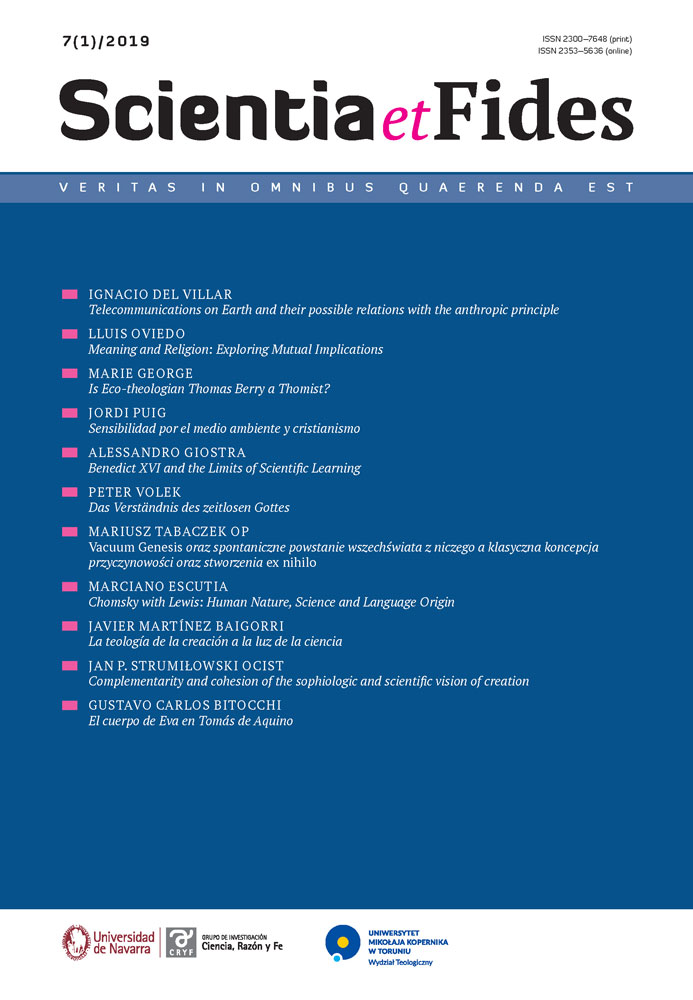Review of Naturaleza Creativa
Keywords
philosophy of nature, evolution, relationship to nature, boundary questions, form and finalityAbstract
The short monograph Creative Nature (Francisco Javier Novo, Rubén Pereda, and Javier Sánchez -Cañizares. 2018. Naturaleza Creativa. Madrid: Rialp. ISBN: 978-84-321-4916-0. 196 pp. Paperback, €14.25) is a welcome contribution to the philosophy of nature that arose from interdisciplinary conversations between authors who are both up-to-date in the scientific literature and deeply grounded in the western intellectual tradition. The authors draw from modern physics, biochemistry, evolutionary biology, developmental biology and ecology to argue that nature is creative in the sense that an “open future” of our evolving world lies ahead. In this review essay, divided into three parts, we offer a chapter-by-chapter summary covering Nature, Life, Change, Limits, Functions and Creativity. In conclusion, we offer some pedagogical possibilities. The second part proposes certain points for deeper reflection.
References
Artigas, Mariano. 2006. Knowing Things for Sure: Science and Truth. Lanham, MD: University Press of America.
Artigas, Mariano. 2001. The Mind of the Universe: Understanding Science and Religion. West Conshohocken, PA: Templeton Foundation Press.
Aquinas, St. Thomas. 1918. Opera Omnia Iussu Leonis XIII P. M. Edita, t. 13: Summa Contra Gentiles Liber 1 & 2 Cum Commentariis Ferrariensis. Vol. 13. 50 vols. Romae: Ex Typographia Polyglotta S. C. de Propaganda Fide.
Aristotle. 2014. The Complete Works of Aristotle: The Revised Oxford Translation, One-Volume Digital Edition. Edited by Jonathan Barnes. Princeton, NJ: Princeton University Press.
Ashley, Benedict M. 2006. The Way toward Wisdom: An Interdisciplinary and Intercultural Introduction to Metaphysics, Thomistic Studies. Notre Dame, IN: University of Notre Dame Press.
Bershtein, Shimon, Serohijos, Adrian W.R., and Eugene I. Shakhnovich. 2017. "Bridging the physical scales in evolutionary biology: From protein sequence space to fitness of organisms and populations.” Curr. Opin. Struct. Biol. 42: 31–40.
Burley, Stephen K., Berman, Helen M., Christie, Cole, Duarte, Jose M., Feng, Zukang, Westbrook, John, Young, Jasmine, and Christine Zardecki. 2018. “RCSB Protein Data Bank: Sustaining a living digital data resource that enables breakthroughs in scientific research and biomedical education.” Protein Science 27(1):316–330. http://doi.org/10.1002/pro.3331
De Loof, Arnold. 2017. The evolution of “Life”: A Metadarwinian integrative approach. Communicative and Integrative Biology 10(3):e1301335. Accessed 26 June 2018. http://doi.org/10.1080/19420889.2017.1301335
Dutta, Shuchismita, Eswaran, Subha, Sanelli, Anne, Bhattacharya, Meenakshi, and Richard Tempsick. 2018. Learning biology through molecular storytelling. The Science Teacher 86: 28–33.
Ellis, George F. R. 2016. How Can Physics Underlie the Mind?: Top-Down Causation in the Human Context. Berlin/Heidelberg: Springer.
Harvard University. 2018. “Origins of Life Initiative.” Accessed 15 Aug 2018. https://origins.harvard.edu/
Kant, Immanuel. 1987. Critique of Judgment. Translated by W. S. Pluhar. Indianapolis, IN: Hackett Publishing.
Kauffman, Stuart A. 2003. Preface to Investigations. Oxford University Press.
Murphy, Nancy and William. R. Stoeger, ed. 2007. Evolution and Emergence: Systems, Organism, Persons. Oxford: Oxford University Press.
Murphy, Nancy and Warren S. Brown. 2007. Did My Neurons Make Me Do It?: Philosophical and Neurobiological Perspectives on Moral Responsibility and Free Will. Oxford: Oxford University Press.
Novo, Javier, Pereda, Rubén and Javier Sánchez-Cañizares. 2018. Naturaleza Creativa. Madrid: Railp.
Origins of Life Initiative. 2018. “Video of 3rd Origins Prize Lecture: Sara Seager (MIT) ‘Exoplanets and the Search for Biosignature Gases: An Astronomer's Journey through Chemical Space’, 19 September 2018.” https://origins.harvard.edu/news/video-3rd-origins-prize-lecture-sara-seager-mit-exoplanets-and-search-biosignature
Rizzi, Anthony. 2018. Physics for Realists: Quantum Mechanics. Modern Physics with a Common Sense Grounding. Baton Rouge, LA: IAP Press.
Rizzi, Anthony. 2012. “What is a Physical Thing?” In A Kid’s Introduction to Physics (and Beyond), 9-12. Baton Rouge, LA: IAP Press.
Sacks, Jonathan. 2012. The Great Partnership: Science, Religion, and the Search for Meaning. New York, NY: Schocken.
Unger, Roberto Mangabeira and Lee Smolin. 2014. The Singular Universe and the Reality of Time: A Proposal in Natural Philosophy. Cambridge: Cambridge University Press.
Downloads
Published
How to Cite
Issue
Section
License
CC BY ND 4.0. The Creator/Contributor is the Licensor, who grants the Licensee a non-exclusive license to use the Work on the fields indicated in the License Agreement.
- The Licensor grants the Licensee a non-exclusive license to use the Work/related rights item specified in § 1 within the following fields: a) recording of Work/related rights item; b) reproduction (multiplication) of Work/related rights item in print and digital technology (e-book, audiobook); c) placing the copies of the multiplied Work/related rights item on the market; d) entering the Work/related rights item to computer memory; e) distribution of the work in electronic version in the open access form on the basis of Creative Commons license (CC BY-ND 3.0) via the digital platform of the Nicolaus Copernicus University Press and file repository of the Nicolaus Copernicus University.
- Usage of the recorded Work by the Licensee within the above fields is not restricted by time, numbers or territory.
- The Licensor grants the license for the Work/related rights item to the Licensee free of charge and for an unspecified period of time.
FULL TEXT License Agreement
Stats
Number of views and downloads: 957
Number of citations: 2



